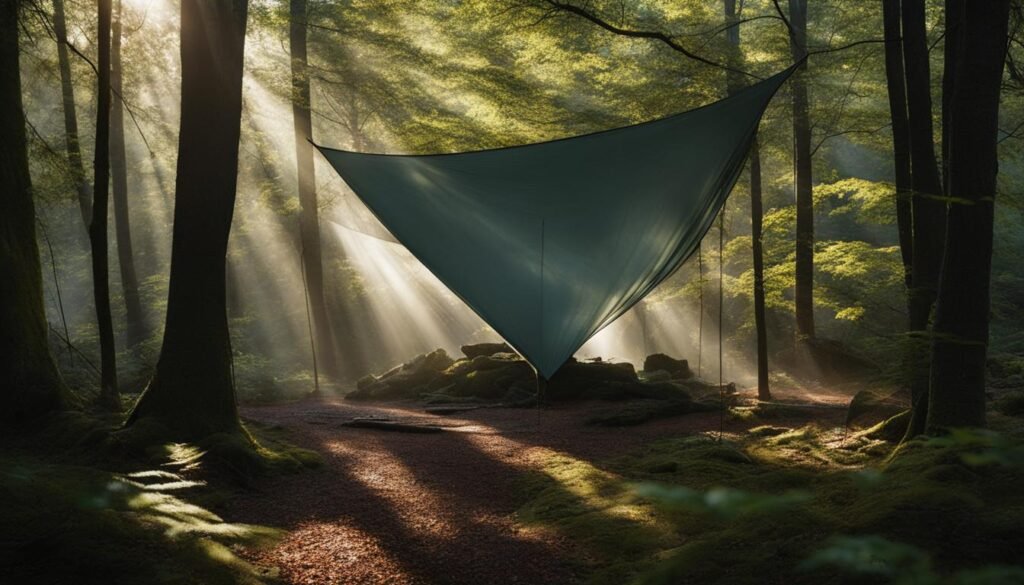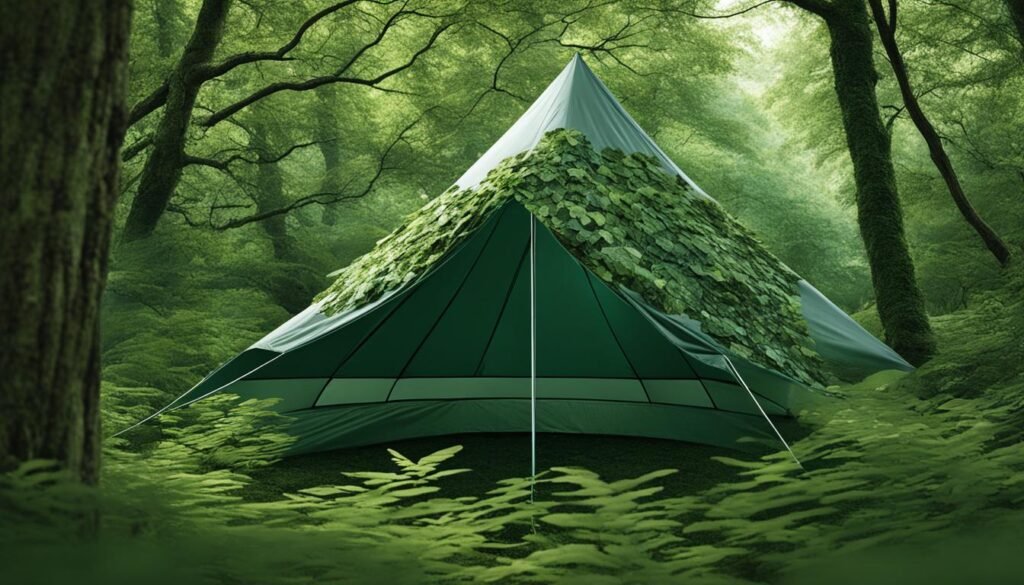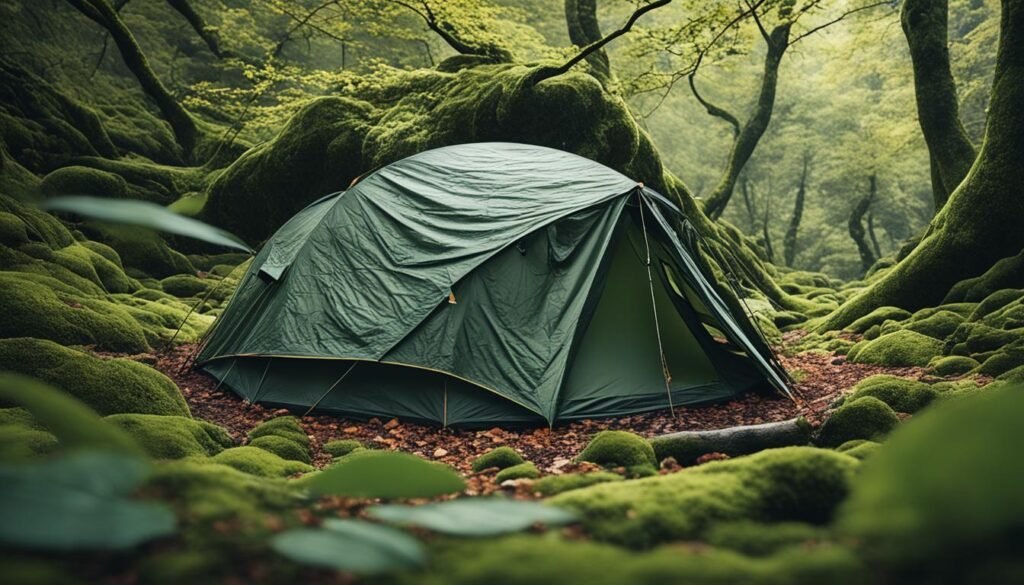As an outdoor enthusiast, blending in with nature is essential for a more immersive camping experience. Camouflaging your tent allows you to remain discreet and avoid detection in natural surroundings. In this article, I will share essential tips and techniques to help you effectively camouflage your tent and enhance your camping adventure.
Key Takeaways:
- Choosing the right colors and patterns for your tent is crucial for effective camouflage.
- Consider using natural materials such as branches and leaves to conceal your tent and break up its shape.
- Camouflage paint can further enhance the effectiveness of your tent’s camouflage.
- Camouflage nets can provide additional camouflage coverage for your tent.
- Take into account your behavior, movement, and camouflage of camping equipment for optimal camouflage.
Understanding the Basics of Camouflage
Camouflage is a technique used to blend into the environment, making oneself or an object difficult to see or detect. When it comes to camouflage, it’s essential to understand the basics to effectively camouflage your tent and immerse yourself in the natural surroundings.
There are different types of camouflage, each serving a specific purpose:
- Natural camouflage: mimicking the colors and patterns found in the surrounding environment.
- Disruptive camouflage: breaking up the outline and shape of an object to make it less visible against various backgrounds.
- Countershading: using a combination of light and dark colors to create an illusion of depth and make an object blend seamlessly into its surroundings.
By understanding these different forms of camouflage, you can incorporate effective techniques to ensure your tent remains inconspicuous.
Tent Camouflage Tips
When camouflaging your tent, consider the following tips:
- Choose appropriate colors: Opt for colors that match the natural environment and blend well with the surroundings. Earthy tones such as olive/gray spectrum are often recommended.
- Blend in with cover: Pitch your tent behind natural cover, such as trees or shrubbery, to create additional camouflage.
- Disrupt the shape: Break up the shape of your tent by attaching natural materials, like branches or leaves, to its exterior. This helps to further blend it into the environment.
By following these tent camouflage tips, you can effectively conceal your tent and seamlessly merge it with the natural surroundings.
“Understanding the basics of camouflage is crucial for effectively blending your tent into the environment.”
To provide a visual example, here’s a table showcasing the differences between different types of camouflage:
| Camouflage Type | Description |
|---|---|
| Natural Camouflage | Uses colors and patterns found in the environment to blend in. |
| Disruptive Camouflage | Breaks up the outline and shape of an object to make it less visible. |
| Counter shading | Uses light and dark colors to create an illusion of depth and blending. |
Understanding the basics of camouflage is essential for effectively camouflaging your tent and enhancing your camping experience. With the right knowledge and techniques, you can seamlessly blend into nature and enjoy a more discreet outdoor adventure.
Choosing the Right Colors and Patterns
When it comes to effective tent camouflage, choosing the right colors and patterns is essential. Solid colors may seem like a convenient choice, but they often fail to blend seamlessly with the natural surroundings. In order to achieve optimal camouflage, you should opt for colors in the olive/gray spectrum that harmonize with woodland tones.
Dark colors are generally more effective than lighter ones when it comes to tent camouflage. They help to disrupt the tent’s shape and make it less noticeable. Additionally, it is crucial to pitch your tent behind cover, such as trees or bushes, to further enhance its camouflage.
By carefully selecting the colors and patterns for your tent, you can significantly improve its ability to blend into the environment. This not only enhances your camping experience but also allows you to stay hidden from potential observers.
Color and Pattern Options for Tent Camouflage
When considering which colors and patterns to use for your tent, keep the following options in mind:
- Opt for earthy tones such as olive greens, grays, and browns that match the natural environment.
- Consider using camouflage patterns specifically designed for outdoor environments, which feature a combination of colors and shapes that mimic natural surroundings.
- Experiment with textures and patterns that replicate the look of rocks, leaves, or bark, further enhancing the tent’s ability to blend in.
- Be mindful of the season and the specific location where you will be camping. Adjust the colors and patterns accordingly to match the prevailing colors of the landscape.
By choosing the right colors and patterns for your tent, you can effectively camouflage it and increase your chances of going unnoticed in the great outdoors.
“The key to successful tent camouflage lies in choosing colors that blend with the environment and patterns that imitate natural elements.”
– Outdoor Enthusiast
Exploring Camouflage Fabrics
When it comes to camouflaging your tent, the type of fabric you choose plays a crucial role in its effectiveness. By selecting the right fabric, you can enhance the blending capabilities of your tent with the natural environment. Let’s explore some camouflage fabrics that are perfect for setting up your outdoor gear.
One popular choice among outdoor enthusiasts is silnylon or silpoly fabric. These fabrics come in shades of olive drab or foliage green, which allows them to blend seamlessly with the surrounding foliage. The subtle earthy tones mimic the colors found in nature, making your tent less visible to prying eyes.
Considering factors such as denier, weight, and waterproof properties is essential when selecting a camouflage fabric for your tent. A higher denier fabric offers better durability, making it suitable for rugged outdoor adventures. Similarly, a lightweight fabric is ideal for backpackers who prioritize convenience and ease of transport. Furthermore, opting for a waterproof fabric ensures that your tent remains dry and functional during unexpected rain showers.
To give you a clearer understanding, here is a comparison table of popular camouflage fabrics:
| Camouflage Fabric | Denier | Weight | Waterproof Properties |
|---|---|---|---|
| Silnylon | 20D-70D | Lightweight | Water-resistant |
| Silpoly | 30D-70D | Lightweight | Waterproof |
| Polyester | 210D-600D | Durable | Water-resistant or waterproof |
By carefully considering the attributes of different camouflage fabrics, you can choose the perfect fabric that suits your specific needs and camping style. Whether you prioritize durability, weight, or waterproof properties, there is a camouflage fabric out there that will help you set up a tent that seamlessly blends with nature.
Using Natural Materials to Conceal Your Tent
When it comes to camouflaging your tent, utilizing natural materials can be an effective strategy to enhance its concealment. By incorporating branches, leaves, or grass into the design of your tent, you can break up its shape and pattern, allowing it to blend seamlessly with the surrounding environment.
One technique is to attach these materials directly to your tent, creating a natural cover that mimics the textures and colors of the area. Secure branches or leaves to the exterior of your tent using ropes or clips, ensuring they are arranged in a way that provides optimal camouflage.
Alternatively, you can use natural materials to create a canopy or additional cover around your tent. By constructing a barrier of branches, leaves, or tall grasses, you can effectively conceal your tent, making it less noticeable and reducing its visibility to passersby.
Matching Colors and Textures
When gathering natural materials, it is important to consider the local environment and select items that perfectly match the colors and textures of the area. Look for branches, leaves, or grasses that closely resemble those found in the surrounding landscape.
The goal is to create a seamless blend between your tent and the natural elements. By carefully choosing materials that closely resemble the local flora, you can significantly enhance the camouflage and ensure your tent remains undetectable.
Benefits of Natural Materials
Using natural materials for tent concealment offers several advantages. Firstly, it provides a more environmentally friendly approach compared to artificial camouflage. By utilizing resources sourced from the surrounding area, you minimize your impact on the environment and leave no trace behind.
Additionally, natural materials are readily available in most outdoor settings, making them easily accessible for campers and hikers. Instead of relying solely on specialized camouflage gear, you can use what nature provides to effectively conceal your tent.
“By incorporating natural materials into your tent design, you can create a seamless blend with the environment, ensuring your tent goes unnoticed by both humans and wildlife.”
Remember to be mindful of your surroundings and ensure that the materials you gather do not damage or disrupt the ecosystem. Always follow Leave No Trace principles and leave the natural environment as you found it.
Applying Camouflage Paint
Camouflage paint is a powerful tool for taking your tent’s camouflage to the next level. By choosing the right paint colors and employing irregular patterns, you can enhance your tent’s blending capabilities even further. Consider the lighting conditions and adjust the paint accordingly to ensure optimal camouflage. It’s important to cover any shiny objects that could give away your tent’s location and make sure that the paint does not create any unnatural patterns or shadows.
When selecting camouflage paint for your tent, opt for colors that closely match the surrounding environment. Look for shades and tones that blend seamlessly with the natural elements in your camping area. By doing so, you’ll maximize the effectiveness of your tent’s camouflage and make it virtually invisible to the naked eye.
“Camouflage paint is a versatile solution that can greatly enhance your tent’s ability to blend in with the environment.”
Irregular patterns play a vital role in breaking up the tent’s outline and making it harder to distinguish from its surroundings. Experiment with various brushstroke techniques or use natural objects like leaves, twigs, or sponges to create unique patterns that mimic the textures found in nature. By adding these irregular patterns, you increase the chances of your tent going unnoticed, giving you the advantage of a hidden shelter in the wilderness.
It’s essential to consider the lighting conditions of your camping area when applying camouflage paint. Take note of how the sunlight or artificial lighting casts shadows and affects the visibility of your tent. Adjust the paint tones and patterns accordingly to blend harmoniously with the lighting conditions and avoid any discrepancies that could give away your position. By adapting to the lighting, you ensure that your tent remains inconspicuous throughout the day and night.
Remember to cover any shiny surfaces with camouflage paint as they can catch light and attract attention. Reflective materials or glossy objects can easily compromise the effectiveness of your camouflage, so be thorough in ensuring that all surfaces are adequately painted and blended with the surroundings.
By applying camouflage paint to your tent, you can significantly improve its ability to hide in plain sight. With the right colors, patterns, and attention to detail, you can achieve a level of camouflage that keeps you concealed and undetected in the great outdoors.
Camouflaging Your Tent with Nets
One effective way to enhance the camouflage of your tent is by utilizing camouflage nets. These nets serve as a useful tool to cover your tent and provide additional camouflage. They are typically designed with colors that match the natural environment and may feature 3D elements to break up the shape and shadow of the tent, making it blend seamlessly into the surroundings.
When using a camouflage net, it is important to ensure that it fully covers the tent, leaving no exposed areas. This will help create a more cohesive camouflage effect and prevent any parts of the tent from standing out. Additionally, make sure that the net is securely fastened to the tent to avoid any movements or flapping that could potentially attract attention.
Camouflage nets are available in various sizes and configurations to accommodate different tent sizes. Choose a net that is large enough to adequately cover your tent, while still allowing for proper ventilation and access to the tent’s entrance.
Remember to carefully position the net to match the surrounding environment. Pay attention to the colors, patterns, and textures of the area, and adjust the net accordingly to achieve optimal camouflage. The goal is to ensure that the net seamlessly blends with the natural elements, making it difficult for others to spot your tent.
For improved camouflage effectiveness, consider using additional natural materials, such as branches or foliage, to further break up the outline and shape of the tent when using a camouflage net. This combination of natural materials and camo netting will provide a layered and realistic camouflage appearance.

Camouflage nets are an excellent addition to your tent camouflage toolkit, providing an extra layer of concealment and enhancing your ability to blend in with the environment. By incorporating nets into your camouflage strategy, you can ensure the utmost discretion during your outdoor adventures.
Proper Behavior and Movement
Your behavior and movement are crucial factors in ensuring the effectiveness of your tent’s camouflage. By adopting the right tactics, you can minimize the chances of detection and fully immerse yourself in the natural environment.
Moving Slowly and Carefully
When navigating your campsite or surrounding areas, it’s crucial to move with caution and finesse. Avoid quick movements that may draw attention to your location. Instead, opt for slow, deliberate steps to blend seamlessly with the peaceful surroundings.
Avoiding Silhouetting
One of the most common mistakes campers make is inadvertently creating a silhouette against the sky or light backgrounds. These silhouettes make it easier for others to spot your presence and compromise your camouflage. Stay mindful of your positioning and avoid standing in areas where you are backlit or clearly outlined against the background.
Utilizing Shadows and Natural Features
Take advantage of the shadows and natural features in your vicinity to conceal your movements. Move through shaded areas whenever possible, as they offer a natural cover that can help you remain undetected. Utilize trees, bushes, and other objects as concealment to break up your outline and blend into the environment.
Being Aware of Your Surroundings
Always stay vigilant and aware of your surroundings. By keeping a keen eye on the activities around you, you can proactively avoid unnecessary attention and adjust your movements accordingly. Pay attention to sounds, movement, and any signs of human presence to ensure your camouflage remains intact.
“Moving slowly, avoiding silhouetting, utilizing shadows, and being aware of your surroundings are essential strategies to maintain the effectiveness of your tent’s camouflage.”
By following these tent camouflage tips and techniques in deploying proper behavior and movement, you can increase your chances of seamlessly blending in with the natural landscape and enjoy a truly immersive outdoor experience.
Camouflaging Your Camping Equipment
When it comes to blending in with your surroundings, camouflaging your camping equipment is just as important as camouflaging your tent. After all, your backpacks, sleeping bags, and cooking utensils can easily give away your presence in the wilderness if they stand out. To ensure a seamless blend with nature, consider employing various techniques to camouflage your camping gear.
Camouflage Covers
One effective way to conceal your camping equipment is by using camouflage covers. These covers are designed to match the natural environment, making your gear blend in seamlessly. Whether it’s a backpack cover, a sleeping bag cover, or covers for your cooking utensils, opt for patterns and colors that closely resemble the surrounding landscape.
Camouflage Paint
Camouflage paint can also be a valuable asset in disguising your camping equipment. By painting your gear to match the environment, you can further enhance its camouflage effectiveness. Choose earthy tones and irregular patterns that mimic the textures and colors of your surroundings. A combination of brown, green, and gray shades is often ideal for achieving optimal camouflage.
Camouflage Nets
Similar to tents, camouflage nets can be used to cover your camping equipment and provide additional concealment. These nets are typically designed with 3D elements and familiar patterns that break up the outlines and shadows of your gear, making them less noticeable. Make sure the nets are properly positioned and blend seamlessly with the environment for maximum camouflage effect.
Visual Example:
| Camouflage Equipment | Camouflage Technique |
|---|---|
| Backpacks | Using camouflage covers or sprays |
| Sleeping bags | Applying camouflage paint or using camouflage covers |
| Cooking utensils | Wrapping them in camouflage covers or using nets |
By implementing these camouflage techniques, you can ensure that your camping equipment seamlessly blends in with the surrounding environment. This level of camouflage not only enhances your overall concealment but also contributes to a more immersive and undisturbed outdoor experience.
Remember, the key to effective camouflage lies in mimicking the colors, patterns, and textures of your surroundings. By taking the time to camouflage your camping gear, you can enjoy a more discreet camping experience while respecting and appreciating the natural beauty around you.
Terrain Masking and Disguise
When it comes to camouflaging your tent, utilizing the natural features of the terrain can be highly effective. Terrain masking involves strategically placing your tent in a way that takes advantage of the landscape to minimize its visibility. By using the shadow of a hill or positioning your tent behind trees, you can help blend it seamlessly into the surroundings.
To further enhance the camouflage, consider disguising your tent as something else entirely. This technique involves making your tent resemble a rock or a fallen tree, making it even more difficult to detect. By mimicking the appearance of these natural elements, you can achieve an unparalleled level of tent blending.
Remember, the key to successful terrain masking and disguise is careful observation of the environment. Take the time to assess the landscape and choose the most suitable location for your tent. By leveraging the natural features and adapting your tent’s appearance, you can achieve optimal camouflage and enjoy a truly immersive outdoor experience.

Terrain Masking and Disguise Techniques
| Technique | Description |
|---|---|
| Shadow Placement | Positioning the tent in the shadow of a hill or behind trees to minimize visibility. |
| Disguise as a Rock | Creating a tent cover or attachment that resembles a rock, making it blend in with the surrounding terrain. |
| Disguise as a Fallen Tree | Using camouflage materials or attachments to transform the tent into the appearance of a fallen tree. |
Using Light and Shadow to Your Advantage
When it comes to camouflaging your tent, understanding the role of light and shadow is crucial. The way light interacts with your surroundings can greatly impact the visibility of your tent, either revealing its shape or enhancing its concealment. By leveraging light and shadow to your advantage, you can optimize your tent’s camouflage and blend seamlessly with the environment.
In areas with bright sunlight, be mindful of the strong shadows that can be cast, potentially revealing the shape and location of your tent. Position your tent in a way that minimizes these shadows, ensuring they don’t give away your presence to others in the vicinity.
On the other hand, overcast conditions can work in your favor by reducing the presence of shadows and making camouflage more effective. Take advantage of these conditions to further blend in with the surroundings and remain undetected.
When assessing the lighting conditions of your camping area, pay close attention to the position of the sun throughout the day. By being aware of the sun’s movement and the resulting changes in light and shadow, you can adjust your tent’s camouflage accordingly, adapting it to the specific conditions of each moment.
Remember that the success of your camouflage relies on your ability to adapt and respond to the ever-changing lighting conditions. Regularly reassess and refine your camouflage strategy to ensure maximum effectiveness.
Training and Practice
Mastering the art of tent camouflage requires dedicated training and practice. By studying the principles of camouflage and honing your skills, you can effectively blend into various environments and situations. Here are some key steps to help you become adept at DIY tent camouflage:
- Understand the Principles: Start by gaining a thorough understanding of camouflage techniques. Learn about color theory, patterns, and how to break up the shape and silhouette of your tent.
- Apply Camouflage: Practice applying camouflage in different environments to develop your skills. Experiment with natural materials, camouflage nets, and paints to find the techniques that work best for you.
- Observe and Adapt: Train yourself to observe your surroundings and understand how others might perceive your camouflage. Pay attention to lighting conditions, shadows, and movement to make adjustments that enhance your camouflage effectiveness.
- Regular Practice: Regularly practice your camouflage skills in various settings. Set up your tent in different terrains, such as woods, grasslands, or rocky areas, and practice blending in effectively.
- Learn from Experts: Seek guidance from expert campers or military personnel with experience in camouflage techniques. Their insights and tips can greatly enhance your understanding and skills.
Remember, DIY tent camouflage is an art that requires practice and a keen eye for detail. With dedication and regular training, you can become proficient in the art of blending in with nature and enjoy a more discreet and immersive outdoor experience.
Camouflage Training Checklist
| Training Steps | Status |
|---|---|
| Study camouflage principles and techniques | ✓ |
| Practice applying camouflage in different environments | ✓ |
| Observe and understand how others perceive your camouflage | ✓ |
| Regularly practice tent camouflage in various settings | ✓ |
| Seek guidance and learn from camouflage experts | ✓ |
Are Camouflaged Tents More Likely to Attract Bears?
When camping in bear country, it’s important to consider whether camouflaged tents are more likely to attract bears. According to bear country camping tips, brightly colored tents are recommended to increase visibility and reduce the risk of surprising a bear. It’s best to prioritize safety over blending into the surroundings.
Conclusion
Camouflaging your tent is an essential skill for outdoor enthusiasts looking to blend in with nature. By choosing the right colors, using natural materials, applying camouflage paint, and utilizing nets, you can effectively camouflage your tent and enhance your camping experience. Remember to consider behavior, movement, and camouflage of your camping equipment as well. With training and practice, you can become proficient in the art of tent camouflage and enjoy a more discreet outdoor experience.
Camouflaging your tent starts with selecting the appropriate colors and patterns that blend well with the natural environment. Avoid solid colors and opt for shades in the olive/gray spectrum that match woodland tones. Additionally, using natural materials like branches and leaves to conceal your tent will help break up its shape and pattern, seamlessly blending it into the surroundings.
Applying camouflage paint to your tent can further enhance its ability to blend in with the environment. Choose colors that match the local surroundings and use irregular patterns to create a more natural appearance. Additionally, consider utilizing camouflage nets to provide additional cover for your tent, ensuring it remains well-hidden.
Remember to also take into account your behavior and movement when camouflaging your tent. Move slowly and carefully, avoid silhouetting yourself against bright backgrounds, and utilize natural features like shadows for cover. Lastly, make sure to camouflage your camping equipment as well, ensuring that all gear blends well with the surroundings for maximum camouflage effectiveness.
FAQ
What is camouflage?
Camouflage is a technique used to blend into the environment and make oneself or an object difficult to see or detect.
Why is camouflaging a tent important?
Camouflaging a tent is important for outdoor enthusiasts looking to seamlessly blend in with their natural surroundings and avoid detection.
What colors and patterns should I choose for my tent?
Opt for colors in the olive/gray spectrum that blend well with woodland tones. Solid colors are generally not recommended.
How can I use natural materials to conceal my tent?
Attach branches, leaves, or grass to your tent or use them to create natural cover to break up the shape and pattern of the tent.
Can I use camouflage paint on my tent?
Yes, camouflage paint can be a great way to enhance the camouflage of your tent. Choose colors that match the surrounding environment and use irregular patterns for better blending.
What are camouflage nets and how can I use them to camouflage my tent?
Camouflage nets are colored nets that cover your tent and provide additional camouflage. Ensure that the net fully covers the tent and blends seamlessly with the surrounding environment.
How can my behavior and movement impact the effectiveness of my tent’s camouflage?
Move slowly and carefully, avoid silhouetting yourself against the sky or light backgrounds, utilize natural features for concealment, and stay in the shadows whenever possible.
Should I camouflage my camping equipment as well?
Yes, it is important to camouflage your camping equipment, such as backpacks, sleeping bags, and cooking utensils, to ensure they blend well with the surroundings.
What is terrain masking and how can I use it to camouflage my tent?
Terrain masking involves using the natural features of the terrain to conceal your tent. Place your tent in the shadow of a hill or behind trees to minimize its visibility.
How can I use light and shadow to optimize the camouflage of my tent?
Consider the lighting conditions of the area and adjust your camouflage accordingly. Bright sunlight can create strong shadows that reveal the shape of your tent, while overcast conditions can reduce shadows and make camouflage more effective.
How can training and practice help me improve my tent camouflage skills?
Mastering camouflage techniques requires training and practice. Study the principles of camouflage, practice applying camouflage in different environments, and regularly practice your skills to improve your ability to blend into various situations.







